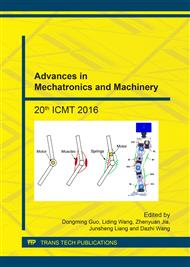p.15
p.21
p.27
p.33
p.39
p.45
p.51
p.58
p.64
Nonlinear Friction Compensation of a Flexible Robotic Joint with Harmonic Drive
Abstract:
To suppress the abrupt and unexpected turning velocity fluctuation of the industrial robot under the condition of trajectory tracking, a flexible robotic joint experimental setup with the harmonic drive was established. The measured friction with Stribeck effect and velocity were modeled by a simple polynomial fit method. Two friction compensation control strategies of feedforward and feedback were designed. The friction compensation experiments were carried out on the dSPACE system, the good restraint effect of fluctuation on the turning velocity was verified and the control accuracy of feedback compensation control strategy proved better.
Info:
Periodical:
Pages:
39-44
Citation:
Online since:
July 2017
Authors:
Keywords:
Price:
Сopyright:
© 2017 Trans Tech Publications Ltd. All Rights Reserved
Share:
Citation:


